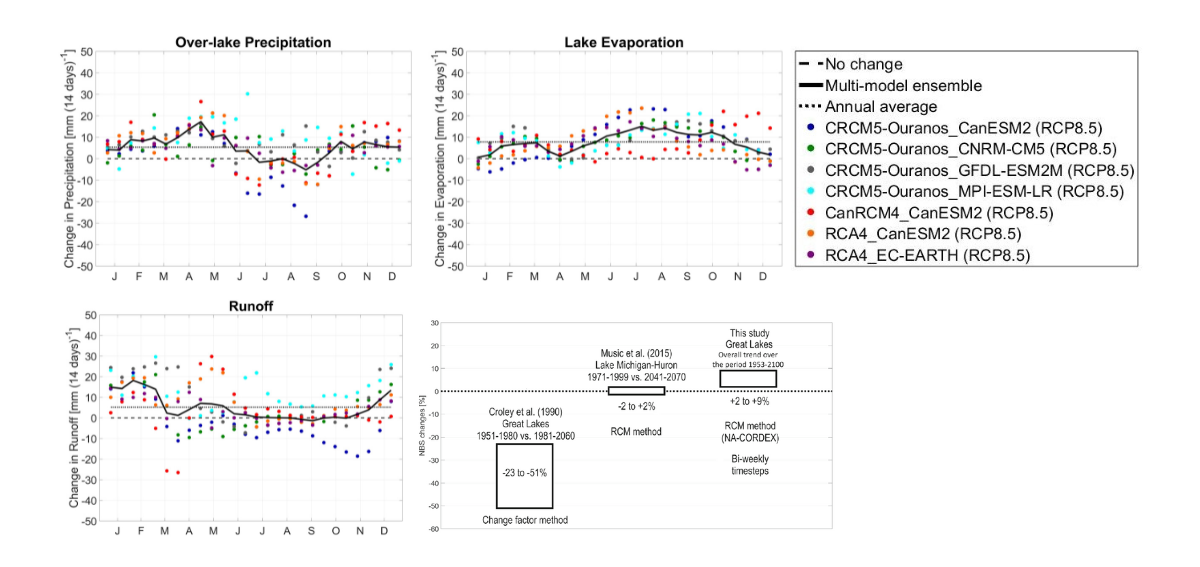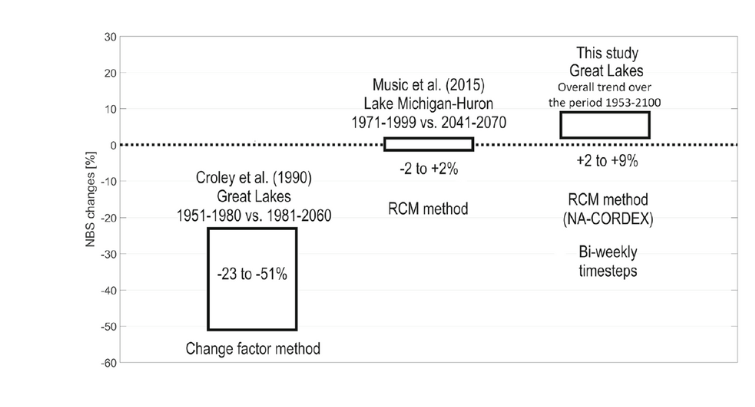Assessment of Future Climate Conditions in the Great Lakes-St. Lawrence Basin
This project has increased knowledge of the components of Great Lakes water supply based on observations of their variability and associated uncertainties.
Project details
Principal(s) investigator(s)



Context
Over the past few decades, many of the climate scenarios derived from global climate models have been explored in various studies whose common goal has been to predict water levels in the Great Lakes in a warmer climate. However, these projections remain questionable, as the majority do not take interactions between the atmosphere, lake surfaces and the surrounding soils into account. In addition, global climate models do not have a great enough perception of the Great Lakes, as their spatial resolution is about 250 km. For this reason, more effort is needed to study the Great Lakes watershed using regional climate models (RCMs).
These models have finer spatial resolution (25 to 50 km), allowing them to represent the hydrology of the Great Lakes more realistically. In addition, this approach makes it possible to diagnose the effects of climate change on the components of the Great Lakes water balance by considering interactions between the surface and the atmosphere, while respecting the conservation of energy at the surface, which was traditionally neglected in projections based on hydrological models. The scientific community has put a great deal of effort into better understanding the effects of climate change on the hydrological regime of the Great Lakes.

Objective(s)
-
Increase knowledge on the components of the Great Lakes’ water supply based on observations of their variability and associated uncertainties.
-
Develop climate change projections for the Great Lakes to support several research efforts aimed at improving understanding of the potential consequences on water supply in the Great Lakes–St. Lawrence basin.
-
Assess the impacts of climate change on the Great Lakes’ water supply.
Methodology
-
Creation of a database of historical data including observations and simulations for the basic variables of the water and energy balances in the Great Lakes basin.
-
Development of new, more refined climate projections for the Great Lakes basin with an ensemble of late-generation RCMs, including those participating in the North American Coordinated Regional Downscaling Experiment (NA-CORDEX).
-
Collaboration with the St. Lawrence Action Plan, the aim of which is to model future water levels in the St. Lawrence River.
Results
As part of this project, we created a database of observed and simulated data for several variables to quantify the Great Lakes water regime in a changing climate. Specifically, an ensemble of 28 simulations from five regional climate models, driven by several global climate models, was used to assess the net basin supply (NBS) of the Great Lakes from 1953 to 2100 using RCP4.5 and RCP8.5 future emission scenarios. Trends in the mean values of the NBS and each of its components were studied using the Theil-Sen statistical test.
The results suggest increases in evaporation over the Great Lakes between 1953 and 2100 of 136 and 204 mm for the RCP4.5 and RCP8.5 scenarios, respectively. For precipitation, amplifications of 83 and 140 mm are projected, while for runoff, all models suggest an increase of 68 and 135 mm for the RCP4.5 and RCP8.5 scenarios, respectively.
The changes are not evenly distributed throughout the year, as significant differences exist from season to season. The projected changes in the Great Lakes’ NBS are positive in winter and spring and negative in summer. Over the full year, increases of 14 and 70 mm are projected for the RCP4.5 and RCP8.5 scenarios, respectively.
The analysis of the annual extreme values, based on the extreme value theory, reveals a significant increase in annual precipitation maxima. For example, for the 50-year return period, increases of 25% and 27% are projected in 1971–2000 and 2041–2070, according to the RCP4.5 and RCP8.5 emission scenarios, respectively. For the annual NBS extremes, projections suggest that the minima will decrease while the maxima will increase. For example, for the 50-year return period, increases of 26% and 29% are projected in 1971–2000 and 2041–2070, according to the RCP4.5 and RCP8.5 emission scenarios, respectively. For the maximal NBS for the same return period, increases of 3% and 9% are projected for 1971-2000 and 2041–2070, according to the RCP4.5 and RCP8.5 emission scenarios, respectively.
In short, this study (Mailhot et al. 2019) provided an update on the effects of climate change on the net water supply of the Great Lakes based on existing projections (see Figure 1) by using state-of-the-art RCMs, which are capable of properly perceiving the lakes and taking the numerous interactions that occur between the surface and the atmosphere into account.

Fig. 1. Biweekly trends over the period 1953–2100 according to Theil-Sen estimators using the RCP8.5 scenario for (a) precipitation over the Great Lakes, (b) evaporation from the lakes, (c) the flow into the lakes, expressed as the nappe of the lakes, and (d) the NBS.

Fig. 2. Comparison of projected changes in the Great Lakes’ net basin supply (NBS) based on the CRCM5 and three other RCMs participating in the NA-CORDEX (our study, Mailhot et al. 2019) with the changes projected by the CRCM4 and NARCCAP (Music et al. 2015). Those reported by Croley et al. (1990), based on traditional hydrological models, do not take into account the energy balance at the surface and thus neglect the interactions between the atmosphere and the surface of the lakes and the surrounding soils.
Benefits for adaptation
Benefits for adaptation
The database of simulated data for various variables associated with the Great Lakes water regime, derived from several regional climate models, allowed Ouranos and its members to further explore issues related to climate change impacts and adaptation in the Great Lakes and St. Lawrence region.
The improved knowledge of Great Lakes hydrology in a changing climate, as well as the data generated, will be used to produce more reliable projections of future water levels in the Great Lakes and the St. Lawrence. This will provide a better understanding of the socio-economic and environmental vulnerabilities associated with variations in flows and water levels (for example, potential usage conflicts).
With more reliable information, it will be possible to identify better adaptation measures for the various components of the St. Lawrence (physical, living, socio-economic, etc.) in a changing climate.
Scientific publications
Funding
This project is funded by the Government of Quebec and meets the objectives of the Plan pour une économie verte 2030.


